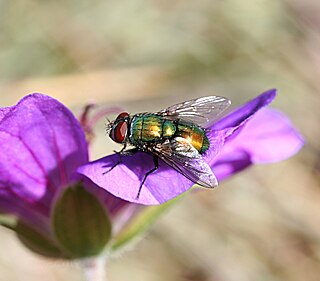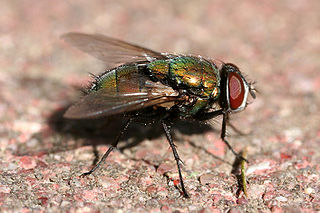
The Calliphoridae are a family of insects in the order Diptera, with 1,200 known species. The maggot larvae, often used as fishing bait, are known as gentles. The family is known to be polyphyletic, but much remains disputed regarding proper treatment of the constituent taxa, some of which are occasionally accorded family status.

The common green bottle fly is a blowfly found in most areas of the world and is the most well-known of the numerous green bottle fly species. Its body is 10–14 millimetres (0.39–0.55 in) in length – slightly larger than a house fly – and has brilliant, metallic, blue-green or golden coloration with black markings. It has short, sparse black bristles (setae) and three cross-grooves on the thorax. The wings are clear with light brown veins, and the legs and antennae are black. The larvae of the fly may be used for maggot therapy, are commonly used in forensic entomology, and can be the cause of myiasis in livestock and pets.
Lucilia is believed to have been the wife of the Roman philosopher Lucretius, though there is little evidence of their relationship, let alone marriage. Moreover, the name 'Lucilia' was not associated with Lucretius until many centuries after his death. In Walter Map's twelfth century work titled De nugis curialium, 'Lucilia' is the name of a woman who murders her husband by giving him a potion that causes him to go insane. It wasn't until 1511, in Pius's vita, that the name 'Lucilia' became associated with Lucretius. Some have even questioned whether this association was made-up for the sake of writing, that is, to maintain literary style.
The Wisdom of Doctor Dodypoll is a later Elizabethan stage play, an anonymous comedy first published in 1600. It is illustrative of the type of drama staged by the companies of child actors when they returned to public performance in that era.

Lucilia illustris is a member of the fly family Calliphoridae, commonly known as a blow fly. Along with several other species, L. illustris is commonly referred to as a green bottle fly. L. illustris is typically 6–9 mm in length and has a metallic blue-green thorax. The larvae develop in three instars, each with unique developmental properties. The adult fly typically will feed on flowers, but the females need some sort of carrion protein in order to breed and lay eggs.

Lucilia is a genus of blow flies in the family Calliphoridae. Various species in this genus are commonly known as green bottle flies.
Lucilia thatuna belongs to the family Calliphoridae, the species most commonly referred to as the blowflies, and the genus Lucilia. Along with several other species of Lucilia, L. thatuna is commonly referred to as a green bottle fly. L. thatuna is very scarce and not much is known about this particular fly. It has been noted to reside in mountainous regions of the northwestern United States.

The species Lucilia cuprina, formerly named Phaenicia cuprina, is more commonly known as the Australian sheep blowfly.

Lucilia mexicana is a species of blow fly of the family Calliphoridae, one of many species known as a green bottle fly. Its habitat range extends from southwestern North America to Brazil. L. mexicana is typically 6–9 mm in length with metallic blue-green coloring. This species is very similar in appearance to L. coeruleiviridis, the primary difference being that L. mexicana has two or more complete rows of post-ocular setae. L. mexicana has the potential to be forensically important in the stored-products and medicocriminal fields, but more research is needed for the fly to be used as evidence in criminal investigations.

Lucilia coeruleiviridis, formerly Phaenecia coeruleiviridis, is commonly known as a green bottle fly, because of its metallic blue-green thorax and abdomen. L. coeruleiviridis was first discovered by French entomologist Pierre-Justin-Marie Macquart in 1855. It belongs to the family Calliphoridae and is one of many forensically important Diptera, as it is often found on decaying substances. L. coeruleiviridis is one of the most ubiquitous blow fly species in the southeastern United States, particularly in the spring and fall months.

Yvonne Lara da Costa, better known as Dona Ivone Lara, was a Brazilian singer and composer.
{{Automatic taxobox {{DISPLAYTITLE:''Lucilia'' (plant)}} |image = |image_caption = |taxon = Lucilia (plant) |authority = [[Cass.]] |type_species = ''[[Lucilia acutifolia]]'' |type_species_authority = ([[Poir.]]) [[Cass.]] |synonyms_ref=<ref name=y>[http://dixon.iplantcollaborative.org/CompositaeWeb/default.aspx?Page=NameDetails&TabNum=0&NameId=d469f72c-b1df-48ff-b8fe-361d5f76ed1f Flann, C (ed) 2009+ Global Compositae Checklist ] {{webarchive|url=https://archive.is/20141217185838/http://dixon.iplantcollaborative.org/CompositaeWeb/default.aspx?Page=NameDetails&TabNum=0&NameId=d469f72c-b1df-48ff-b8fe-361d5f76ed1f |date=2014-12-17 }}</ref> |synonyms= * ''Oligandra'' <small>Less.</small> * ''Celaena'' <small>Wedd.</small> * ''Pachyrhynchus'' <small>DC.</small> * ''Lucilia'' sect. ''Intermedieae'' <small>S.E.Freire</small> * ''Hymenopholi]'' <small>Gardner</small> |tribus=[[Gnaphalieae]]<ref name=y/> }}

Lucilia bufonivora is a member of the fly family Calliphoridae which are commonly known as blow flies. L. bufonivora is commonly referred to as a toadfly. The adult flies will typically feed on pollen and nectar of flowers, while the larvae are parasitoids that feed mainly on the living flesh of the common toad, leading to the toad's death, though they have been found as parasites on other frog and toad species. It is common in north west Europe.

Lucilia caesar is a member of the fly family Calliphoridae commonly known as blow flies. L. caesar is commonly referred to as the common greenbottle. The adult flies typically feed on pollen and nectar of flowers. The larvae feed mainly on carrion.

Lucilia gemma is a species of fly that belongs to the family Calliphoridae, the species most commonly referred to as the blowflies, and the genus Lucilia. Along with several other species of Lucilia, L. gemma is commonly referred to as a green bottle fly. The species is only known to be native to France.

Enemies at Home is a 2014 historical mystery crime novel by Lindsey Davis and the second book of the Flavia Alba Mysteries series. Set in Ancient Rome beginning in June AD 89, two months after the events of The Ides of April (2013), the novel stars Flavia Albia, the British-born adopted daughter of Marcus Didius Falco. Albia, a widow, works as a "delatrix" in ancient Rome, like Falco. The book's cover bears an image of two silver cups, one toppled, and a broken rope. It carries the strapline: "A Flavia Albia Novel".

Madalena Lucília Iglésias do Vale de Oliveira was a Portuguese actress and singer. She represented Portugal at the Eurovision Song Contest 1966, with the song "Ele e ela".
The 1990 IAAF World Women's Road Race Championships was the eighth, and penultimate, edition of the annual international road running competition organised by the International Amateur Athletics Federation (IAAF). The competition was hosted by Ireland on 14 October 1990 in Dublin and featured one race only: a 15K run for women. There were individual and team awards available, with the national team rankings being decided by the combined finishing positions of a team's top three runners. Countries with fewer than three finishers were not ranked.

Lucilia eximia is a species of blow fly in the family Calliphoridae.














